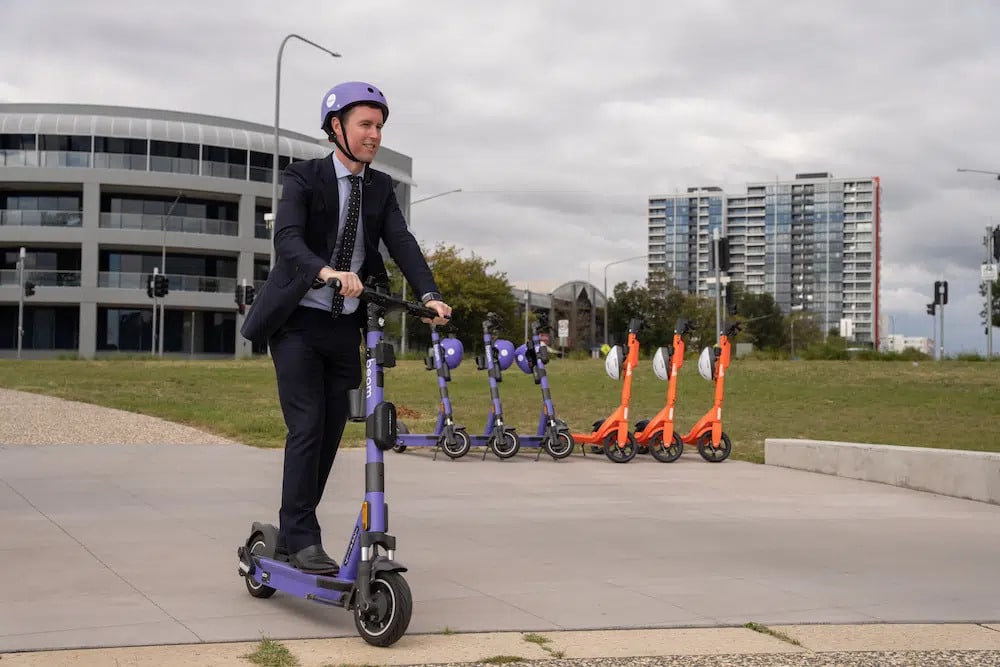New data from e-scooter company Beam shows Canberrans are keen city scooter riders with 180 tonnes of carbon emissions saved in the national capital by residents swapping to the electric transport mode in 2022.
Thanks to the e-scooter’s popularity, the ACT Government, in collaboration with Beam and Neuron, are expanding Canberra’s network to become the largest in Australia.
Data reveals approximately 50 per cent of e-scooter trips would have previously been taken by car, around 90 per cent of e-scooter trips in Canberra are shorter than 5km, and 11 minutes is the average trip time.
Since the 2020 trial, more than 2.4 million e-scooter trips have been taken in Canberra and over one million kilometres were ridden in the past year.
The latest expansion gives Canberrans in 14 southside suburbs access to e-scooter transport:
1. Wanniassa
2. Oxley
3. Monash
4. Greenway
5. Bonython
6. Isabella Plains
7. Coombs
8. Wright
9. Holder
10. Waramanga
11. Stirling
12. Pearce
13. Torrens
14. Farrer
ACT Minister for Transport Chris Steel said Canberra’s e-scooter operating area will now cover more than 132 square kilometres, making Canberra Australia’s largest shared e-scooter city.
“With shared e-scooters now available across the entirety of our city, Canberrans can travel north to south and east to west using a range of shared paths and connecting links,” Mr Steel said.
Bean and Neuron have been working with the ACT Government to implement slow zones, designated parking sites, and no parking zones to keep the scheme “functional and safe”, he said.
“The scheme has proven to be incredibly popular and allows Canberrans from all walks of life to make convenient trips in their local area, or connect to larger journeys using public transport,” Mr Steel said.
Beam Canberra operations manager Ned Dale said the company is committed to introducing new technology and upgrades to improve the safety of Canberrans using the roads.
“Ahead of our expansion into Tuggeranong, we have commenced a trial of tactile signage on our e-scooter to support pedestrians, especially those with blind or low vision, to report badly parked scooters,” Mr Dale said.
“We are also increasing the number of Beam Safety Ambassadors – team members who enforce riding rules – on the streets, keeping a particular eye out on offences like dangerous riding around pedestrians and bad parking.”
Neuron Mobility head of ANZ Richard Hannah said research shows the majority of Neuron trips result in a local business purchase, providing a boost to the Canberra economy.
Mr Hannah said Neuron scooters are “packed with cutting-edge features” that are designed to make them as safe as possible. He encourages riders to learn how to use e-scooters responsibly through their online ScootSafe Academy.
Commuting home from work on an e-scooter is common in Canberra, with peak times spanning throughout the week from 3pm to 6pm on Monday to Thursday, and 5pm to 9pm on Fridays.
Over the weekends, Saturdays from 3pm to 10pm and Sunday from 11am to 4pm are the most popular times to e-scooter.
“The majority of trips on a Beam in Canberra are under five kilometres,” Mr Dale said. “We’re seeing the shorter trips that people used to make in their car – whether a quick duck into the shops, or to grab a coffee – are transferring over to e-scooters, which shows the benefits of shared e-scooters in enabling residents to make a zero-emissions transport choice.”
Top Beam e-scooter routes:
1. Garema Place to Londsdale Street
2. Regatta Point to Kingston Foreshore, via Lake Burley Griffin
3. University Avenue to London Circuit
4. Australian National University to Dickson shops via the C6 cycle path
5. Westfield Woden, via Bradley Street
Get all the latest Canberra news, sport, entertainment, lifestyle, competitions and more delivered straight to your inbox with the Canberra Daily Daily Newsletter. Sign up here.



